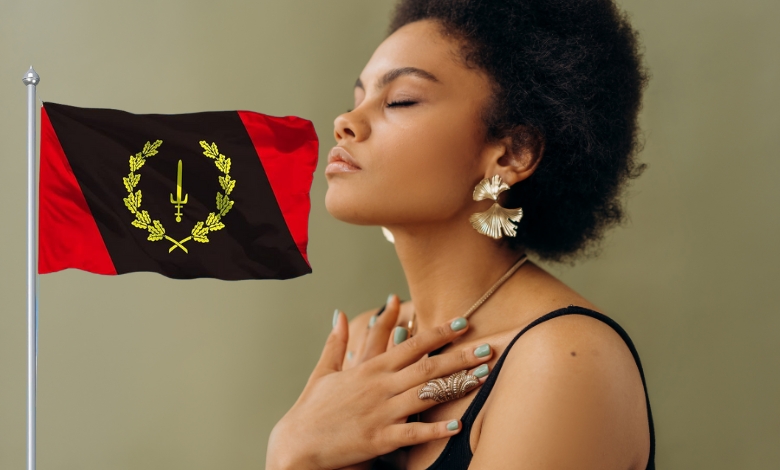Learn the powerful origin, colors, and cultural significance of the African American Heritage Flag and what it symbolizes today.
Flags are never just fabric. They’re declarations. They wave over history, over pain, over triumph. And for African Americans, the African American Heritage Flag is not just a symbol , it’s a reclamation. A defiant and graceful response to centuries of systemic erasure, an answer to the unspoken question: “What flag do we fly that tells our story?”
The African American Heritage Flag was born out of necessity. Not because African Americans lacked history or culture, but because our symbols had too often been co-opted, erased, or ignored. This flag didn’t just appear , it was created with intent, with vision, and with pride.
What You'll Discover:
The Creation of the African American Heritage Flag
In 1967, Melvin Charles and Gaston Edmonds, two Black men from Brooklyn, New York, created the African American Heritage Flag. But this wasn’t just a design project. It was a spiritual undertaking.
They believed that African Americans needed a unique symbol to express cultural pride and honor the African American experience , one that wasn’t confined to American patriotism or Pan-African symbolism.
They asked themselves, “Why don’t we have a flag that’s ours?” And then, they went and built it.
Breaking Down the Colors: What They Truly Represent
The African American Heritage Flag is unapologetically bold. It uses just three powerful colors:
Red: The Lifeblood
Not simply blood spilled, but bloodline. Red honors African ancestry, the sacrifices made, the struggles endured, and the ongoing fight for liberation. It reminds us of those who bled, so we could stand.
Black: The People
Not just the color of the flag, but the color of the people it represents. It stands for identity, dignity, beauty, and resistance. It reclaims the word “Black” as something to be revered, not rejected.
Gold: The Prosperity
Gold symbolizes the wealth of African heritage , spiritual, cultural, intellectual. It’s about legacy. Abundance. Glory. And it’s about the golden light still shining in communities that have endured everything and still rise.
Each color is deliberate. Each shade, layered with meaning. This isn’t aesthetic design , it’s cultural storytelling in motion.
African American Heritage Flag vs Pan-African Flag
It’s common to confuse the African American Heritage Flag with the Pan-African Flag (also known as the UNIA flag, or Red-Black-Green), designed by Marcus Garvey’s movement in 1920. While both celebrate Black identity, they serve different cultural purposes:
| Feature | African American Heritage Flag | Pan-African Flag |
| Colors | Red, Black, Gold | Red, Black, Green |
| Founded | 1967 | 1920 |
| Purpose | Celebrates African American identity | Represents Pan-African unity |
| Usage | African American events, U.S.-based | International Black liberation movements |
Where the Pan-African Flag speaks globally, the African American Heritage Flag zooms in , it tells the story of descendants of American slavery, of resistance and rebuilding in the U.S. context.
Where and How the Flag Is Used Today
The African American Heritage Flag is no longer obscure. While still not as widely known as it deserves, it’s flying higher every year:
- Juneteenth Celebrations: The flag appears alongside traditional African kente cloth and national U.S. flags , asserting Black identity within the American story.
- Black History Month: Schools, libraries, and community centers use it as a centerpiece of their visual displays.
- Churches & Fraternities: Especially those with deep cultural ties like AME churches and Divine Nine sororities/fraternities.
- Murals & Activism: Street art across cities like Atlanta, Baltimore, and Detroit incorporate the flag as a centerpiece.
It has become more than a banner. It’s a proclamation: We are here. We have roots. And we bring value.
The Flag as a Cultural Weapon: Resistance Through Symbolism
Let’s be real. The existence of this flag is, in itself, resistance.
Black Americans were historically excluded from patriotic symbols. The American flag , though technically “everyone’s” , didn’t always feel like it belonged to the Black community. After all, it flew over plantations too.
So, creating and flying your own flag becomes a form of cultural sovereignty. It’s a way of saying:
“We refuse to be invisible. We will name ourselves. We will symbolize ourselves. We will define ourselves.”
This act of visual resistance is vital. Because every nation, tribe, or movement needs its own iconography. And for African Americans, this flag answers that need with dignity.
Personal Connections: Stories Behind the Flag
Ask elders in Black communities who’ve seen the flag raised, and you’ll hear stories like:
“My father cried when I gave him a shirt with that flag on it. He said, ‘I’ve been Black all my life, but I’ve never seen our flag.’”
“We raised the flag during our Juneteenth cookout, and for the first time, the younger kids started asking questions. They didn’t just see red, black, and gold, they saw themselves.”
That’s the power of a flag: It tells you who you are, without you having to say a word.
The Flag and Modern Movements: Reclaiming Public Spaces
As social justice movements have exploded across the U.S., the African American Heritage Flag has become a powerful fixture.
During protests following the murder of George Floyd, it flew alongside fists in the air and chants for justice. It was painted onto signs, shirts, and murals. Not as a replacement for the American flag, but as a counter-narrative , one rooted in the Black American reality.
This flag says:
- “Our story matters.”
- “Our suffering will not be sanitized.”
- “Our identity will not be diluted.”
Why More People Don’t Know About It , Yet
Despite its cultural value, the African American Heritage Flag remains underrepresented. Part of the reason? Lack of institutional promotion. Unlike state flags or national flags taught in schools, this flag is passed down through community, not curriculum.
You won’t see it in a textbook , yet.
But that’s changing. Black educators, community leaders, and content creators are shining light on this symbol and embedding it in lessons, events, and social spaces.
And that’s how cultural revival happens , not by waiting for validation from the top, but by rising up from the roots.
How You Can Honor and Share the Flag
If you’re inspired by this flag, here are meaningful ways to engage with it:
- Fly it proudly at events, homes, or community spaces.
- Teach it to your children or your classroom , explain the colors, the creators, the meaning.
- Wear it on clothing, pins, or jewelry as a sign of solidarity.
- Donate or support nonprofits that promote Black cultural education.
- Create art inspired by the flag , murals, digital design, spoken word.
Remember: Every time the flag is seen, it becomes more embedded in our collective consciousness.
Common Myths & Misconceptions
Let’s clear up a few things:
- It’s not anti-American. It’s not a rejection of the U.S. flag , it’s an assertion of a layered identity.
- It’s not “new.” This flag has existed since 1967. If you’re just now hearing about it, that’s an exposure issue , not a historical one.
- It’s not Pan-African. Though rooted in shared cultural pride, it was made specifically to represent African Americans in the U.S.
Why It Matters Now More Than Ever
We are in an era of cultural awakening. And as America wrestles with its own complicated identity, Black Americans continue to assert theirs , boldly, visually, and symbolically.
The African American Heritage Flag is more than a symbol of pride. It’s an act of historical repair. It fills a void that too many generations were told didn’t exist.
And when you see it flying? That’s not just cloth. That’s 400 years of endurance, stitched into three sacred colors.
Key Takings
- The African American Heritage Flag was created in 1967 by Melvin Charles and Gaston Edmonds to celebrate Black American identity.
- Its colors, red, black, and gold, represent ancestry, identity, and prosperity.
- It is distinct from the Pan-African Flag and centers specifically on the African American experience in the U.S.
- The flag is used during Juneteenth, Black History Month, community events, and activism.
- Flying the flag is a form of cultural resistance and spiritual affirmation.
- Despite limited mainstream exposure, the flag is gaining visibility through education, art, and social media.
- It provides African Americans with a unique symbol that honors their legacy, resilience, and place in history.





